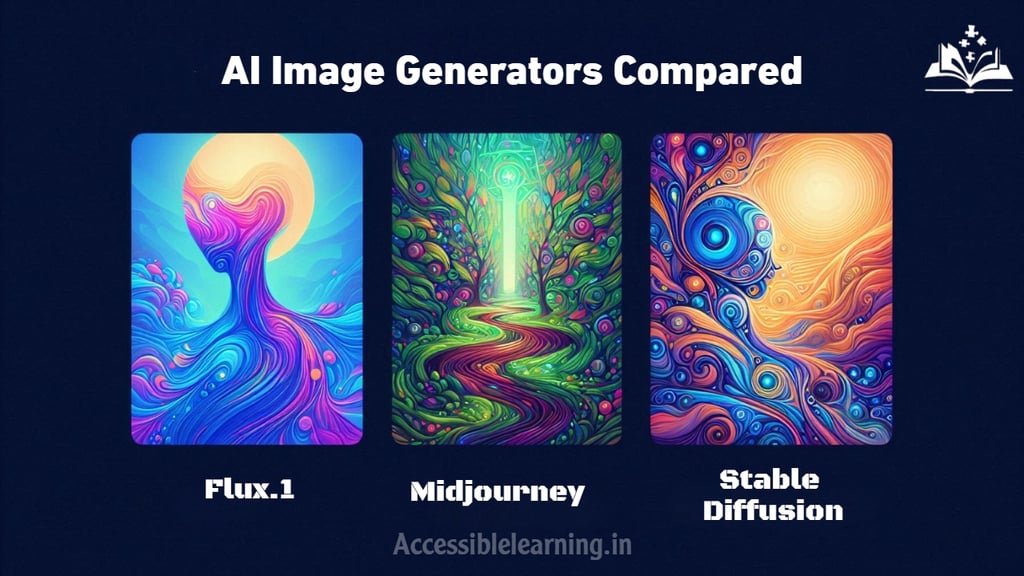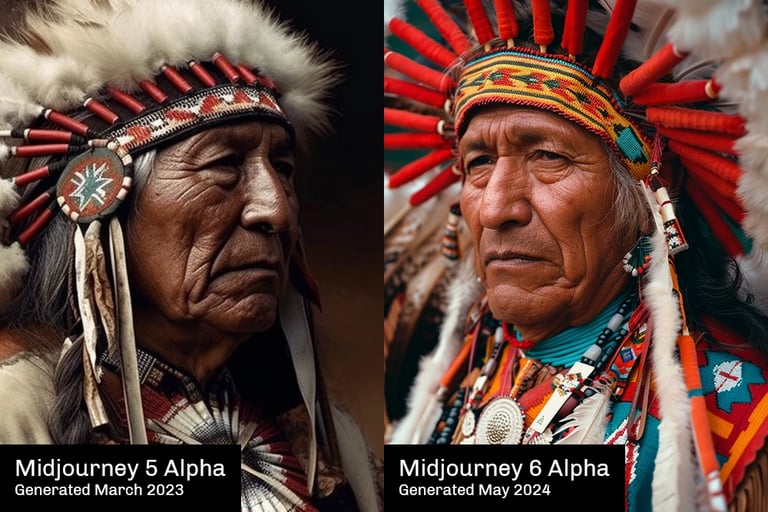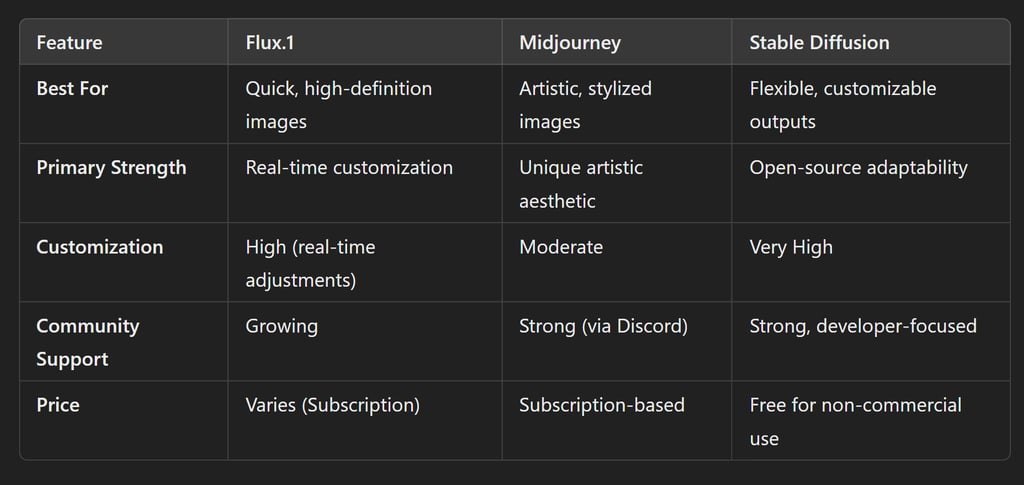
Choosing the Right AI Art Tool: A Deep Dive into Flux.1, Midjourney, and Stable Diffusion?
Explore the differences between Flux.1, Midjourney, and Stable Diffusion in the world of AI-generated imagery. This in-depth comparison examines their unique features, strengths, and ideal use cases to help you choose the perfect tool for your creative projects.
AI ASSISTANTAI/FUTURECOMPANY/INDUSTRY
Sachin K Chaurasiya
11/8/20246 min read


Artificial intelligence has transformed image creation, giving artists, designers, and creators new tools to bring their visions to life. Among these, Flux.1, Midjourney, and Stable Diffusion have emerged as popular choices for generating unique, high-quality images. Each of these platforms offers distinct features and advantages, making it important to understand their differences when choosing the right tool for your project.
Flux.1: Real-Time Customization and Speed!
Flux.1 is a relatively new AI image generator, gaining traction due to its real-time customization options and fast processing speed. Developed with user experience in mind, Flux.1 caters primarily to professionals who need high-quality, customizable visuals for branding, marketing, and design.
Key Features
Real-Time Customization: Unlike other generators that finalize images before any changes can be made, Flux.1 allows you to make adjustments mid-process. This means users can tweak styles, colors, and other elements in real time, creating a truly interactive experience.
Speed: Flux.1 is optimized for fast rendering, making it ideal for time-sensitive projects where quick output is a priority.
Polished Output Quality: The platform produces high-definition images suitable for professional use, focusing on clean, refined visuals that suit commercial and branding needs.
Pros
Interactive Control: Offers more user control, allowing creators to influence the final image on the go.
Fast Turnaround: Flux.1 can generate images rapidly, perfect for fast-paced workflows in marketing and design.
Cons
Limited Community Support: As a newer tool, Flux.1 lacks the extensive community support of other platforms, which could impact accessibility to user-generated tutorials or shared resources.
Ideal For
Professionals in branding, marketing, and product design who require dynamic, quick, and polished outputs with ample customization.


Midjourney: Artistic Flair and Unique Styles!
Midjourney has built a reputation as one of the most creative and visually distinctive AI image generators. It is highly popular with artists and illustrators due to its ability to produce unique, artistic images that look like they’re crafted by human hands.
Key Features
Artistic aesthetic: Midjourney’s output often feels like art in a traditional sense, with rich details, imaginative concepts, and a painterly style. This makes it perfect for creatives who value artistry over realism.
Community and Social Engagement: Midjourney has an active Discord community where users share creations, offer tips, and provide feedback. This community-driven approach fosters creativity and makes it easier for new users to get support.
Customization Options: While not as interactive as Flux.1, Midjourney does allow for a variety of prompt styles, enabling users to experiment with different themes, lighting effects, and degrees of abstraction.
Pros
High Artistic Quality: Known for its aesthetic and stylistic sophistication, Midjourney is the go-to for unique, imaginative, and detailed artworks.
Active Community: Midjourney’s community on Discord creates a collaborative space for users, making it easier to get help and inspiration.
Cons
Limited Realism: Midjourney’s output is often more stylistic than realistic, which might not suit all projects.
Less Control Over Final Output: While customizable, Midjourney doesn’t allow for as much interactive control during image generation as Flux. 1.
Ideal For
Digital artists, storytellers, and creatives looking for detailed, stylized imagery with a unique aesthetic.


Stable Diffusion: Open-Source Flexibility and Developer Control!
Stable Diffusion is an open-source AI image generation platform that has revolutionized accessibility and flexibility in space. As an open-source model, it can be tailored to specific needs, making it highly popular among developers, researchers, and hobbyists who want control over the entire generation process.
Key Features
Open-Source Accessibility: Users can fully modify and customize Stable Diffusion models, adapting them for various image styles and use cases. This makes it a favorite for developers and researchers who want to fine-tune the AI for specific outputs.
Compatibility with Other Tools: Stable Diffusion integrates well with tools like Photoshop plugins, enhancing its functionality within existing workflows.
Community-Driven Models: Since it’s open-source, Stable Diffusion benefits from an active community that contributes models, datasets, and customizations, expanding its capabilities beyond a single-use scenario.
Pros
High Flexibility: Allows users to customize models and create tailored versions for specialized outputs, from photorealistic images to abstract art.
Strong Community Support: An active developer and user community contributes to frequent updates, tools, and troubleshooting resources.
Cost-Effective: Stable Diffusion is free for non-commercial use, which can be a big advantage for small-scale projects and research.
Cons
Steeper Learning Curve: Due to its open-source nature, using stable diffusion effectively may require some technical knowledge.
Limited Out-of-the-Box Polish: While highly customizable, Stable Diffusion’s raw outputs may need refinement to match the polished appearance of Midjourney or Flux. 1.
Ideal For
Developers, researchers, and tech-savvy creatives who want full control over the image generation process and are comfortable with some coding or configuration.
Comparative Analysis: Choosing the Right AI Image Generator!
To choose between Flux.1, Midjourney, and Stable Diffusion, it helps to consider the main factors of your project, such as control, style, speed, and adaptability. Here’s a comparison table for a quick overview:


Final Takeaways: Which One Is Right for You?
Each platform is excellent in its own way, and the choice depends on whether you value speed, style, or customization the most. While MidJourney's beautiful artwork is unmatched for creative projects, Flux.1's dynamic customization serves business needs well, and Stable Diffusion's open-source framework is perfect for those who want to experiment deeply with AI image generation.
For Business and Branding Needs: Flux.1 is ideal, as it combines high-quality output with real-time customization, allowing businesses to generate polished visuals quickly.
For Artists and Storytellers: Midjourney is the top choice for those looking to create beautiful, artistic images with intricate details. Its community-driven approach also makes it perfect for collaborative creativity.
For Developers and Hobbyists: Stable Diffusion’s open-source nature provides unmatched flexibility and control, making it perfect for developers and technical users interested in building custom models or exploring unique styles.
Recent Innovations in Each Platform
Flux.1: Recently introduced adaptive learning features, allowing the AI to tailor outputs based on a user’s previous image generation history. This results in faster iterations and more personalized outputs, making it ideal for recurring projects or brand-specific content.
Midjourney: With its latest version updates, Midjourney has introduced enhanced lighting effects and texture refinement, allowing even more detail and realism in stylized art. Additionally, Midjourney's community on Discord has started weekly challenges where artists can showcase their work, building a strong collaborative space for user creativity.
Stable Diffusion: New fine-tuning options allow users to train Stable Diffusion on specific datasets more easily, and community-created models now cover diverse styles, from hyper-realism to anime-inspired art. Additionally, plugins for apps like Photoshop or GIMP integrate Stable Diffusion directly into creative workflows, making it versatile for various projects.


Comparing Community and Support Resources!
Flux.1: While the community is still growing, Flux.1 has launched a dedicated support forum and a knowledge base where users can find tips and tutorials. This focus on support is especially valuable for beginners or those new to AI image generation.
Midjourney: Midjourney’s Discord server is not just a community; it’s a hub for collaborative learning. Users can participate in daily discussions and weekly design challenges and receive feedback on their work, creating a vibrant learning environment.
Stable Diffusion: With its open-source community, Stable Diffusion has an extensive network of contributed plugins, models, and tutorials available through sites like GitHub. Users can explore community-driven projects that expand Stable Diffusion’s functionality, making it highly versatile.
Pricing Models and Accessibility
Flux.1: Typically subscription-based, with different plans for individual users and businesses. Pricing scales with usage, which can be a drawback for hobbyists but is affordable for professionals needing high-quality output.
Midjourney: Subscription-only, with different pricing tiers. The paid model includes access to higher quality settings and faster processing, making it suited for creatives who prioritize consistency and detailed output.
Stable Diffusion: Free for non-commercial use, which is highly accessible to individuals and small teams. For businesses, some versions require licensing fees, but the cost-effectiveness for large-scale projects is unmatched, especially since it’s open-source and free to modify.
Choosing the right AI image generator depends on your specific needs, creative preferences, and level of technical expertise. Each of these platforms brings its own strengths, and as generative AI technology advances, the possibilities for creating stunning images will only expand further. Whether you’re an artist, a business owner, or a tech enthusiast, there’s likely a tool here that aligns with your vision.
Subscribe To Our Newsletter
All © Copyright reserved by Accessible-Learning Hub
| Terms & Conditions
Knowledge is power. Learn with Us. 📚


